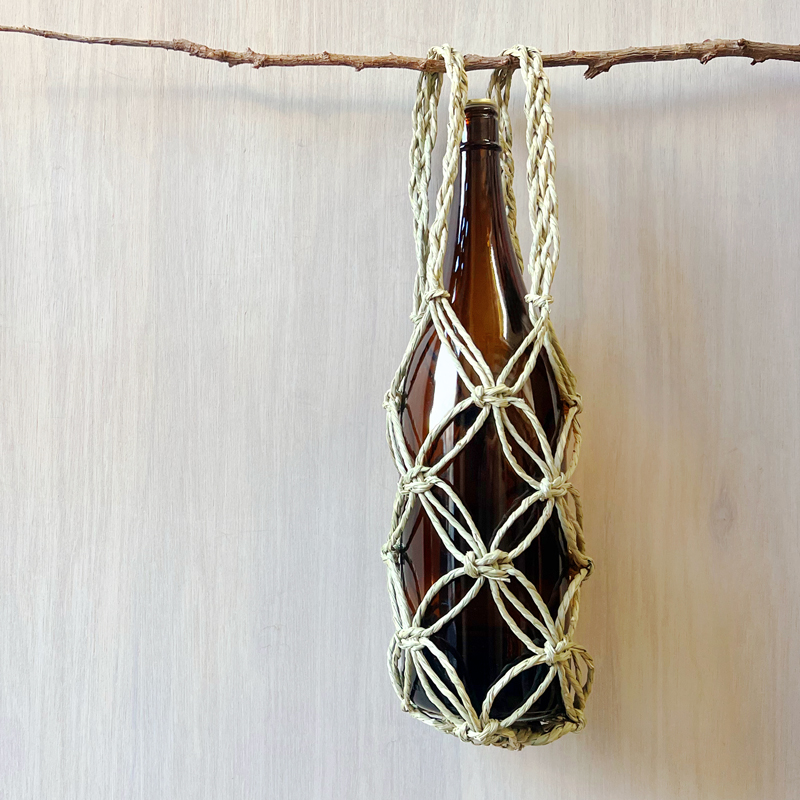#22
keeping / wrapping / drying
Bottle Basket
Sunami Toru Shoten
KURASHIKI, Okayama, Japan
- rush
- approximately H46cm φ12cm
the product:
A “bottle basket" woven with rush. As the name “bottle basket" suggests, it was made to carry a standard L1.8 bottle of soy sauce or sake.Although it is heavy, the handle is thick and easy to hold. It does not get damaged even if it gets a little wet.
The strong bottle baskets are made by twisting rushes into ropes. It is woven seamlessly from the handle to the bottom with sixteen ropes with aligned length. They leave a little rush at the end of the weaving to turn over and finish. It makes the bottom part tight and prevent it from coming loose. It can also be a cushion to soften the impact when put.
The interlocking circles pattern on the body is called “shippou”. With its pattern of eternal circle chains, it is believed to be a lucky pattern for happiness, harmony, and good fortune.
As the woven pattern adjust according to the bottle size, weight, and the shape, it can also fit the smaller bottles than L1.8.
Ryuki, the fifth generation owner of Sunami Toru Shoten, learned the “bottle basket" weaving method from his grandmother and improved the original length of the handles as well as the balance when bottles are placed in the basket, resulting in the current shape.
In addition, to meet the needs of modern life, Ryuki’s idea was to create a smaller “bottle basket (S)” suitable for a wine bottle or 720ml bottle.
You can put a wine bottle in this bottle basket to bring it to a picnic or a home party. It is also perfect to give the bottle basket together with sake as a celebration gift because the interlocking pattern means a good luck. Moreover, it can be used to store vegetables such as onions to hang them well-ventilated. This bottle basket is useful for various purposes.
Rushes change their softness depending on the humidity of the day and are prone to shape irregularities, but they become softer as you use.
The rush of the bottle basket is green, firm, and has a fresh smell at first, then the color turns light brown as time passes.
If you notice any stains, please clean it with a brush or dishcloth.
After multiple use in a humid place, dry it thoroughly in the shade where it is well-ventilated.
(...)
(-)
the maker:
Toru Sunami Shoten was established in 1886.They manufactured tatami mat and floor mats woven with dyed rushes in Kurashiki, where the rush is grown.
The area around Kurashiki used to be a sea studded with islands. However, in the early Edo period (16th century), reclamation began in earnest and the cultivation of rush resistant to salt has begun. In the Meiji period, a technique to dye rush is developed in Kurashiki, and rush floor mats with various decorations began to be produced. These practical and beautiful floor mats were highly valued both in Japan and abroad. After the war, due to full-scale industrialization in Kurashiki, rush fields were turned into houses. Moreover, in the decade of Showa 40s (1965-1975), the production of tatami mats and floor mats ceased as lifestyle changes and most of the people no longer use tatami mats.
Sakae, grandmother of Ryuki, the fifth generation owner, used to weave daily life tools such as baskets and bottle baskets with short rushes, which are not suitable for tatami mats, while weaving tatami mats and rush floor mats.
From a child, Ryuki has been helping Sakae weave and naturally learned how to weave.
Today, using the skills he learned from Sakae, Ryuki continues to make not only baskets and bottle baskets, but also pot mats, watermelon baskets, and rope curtains requested by local people. Even now, when he is busy, Sakae helps him weave each item carefully by hand.
These rushes are used in daily life and will not last a lifetime, however, at Toru Sunami Shoten, they repair them as far as possible. They make efforts to make the repaired part less noticeable by preparing with the same color rushes so that it blends.
(...)
(-)

